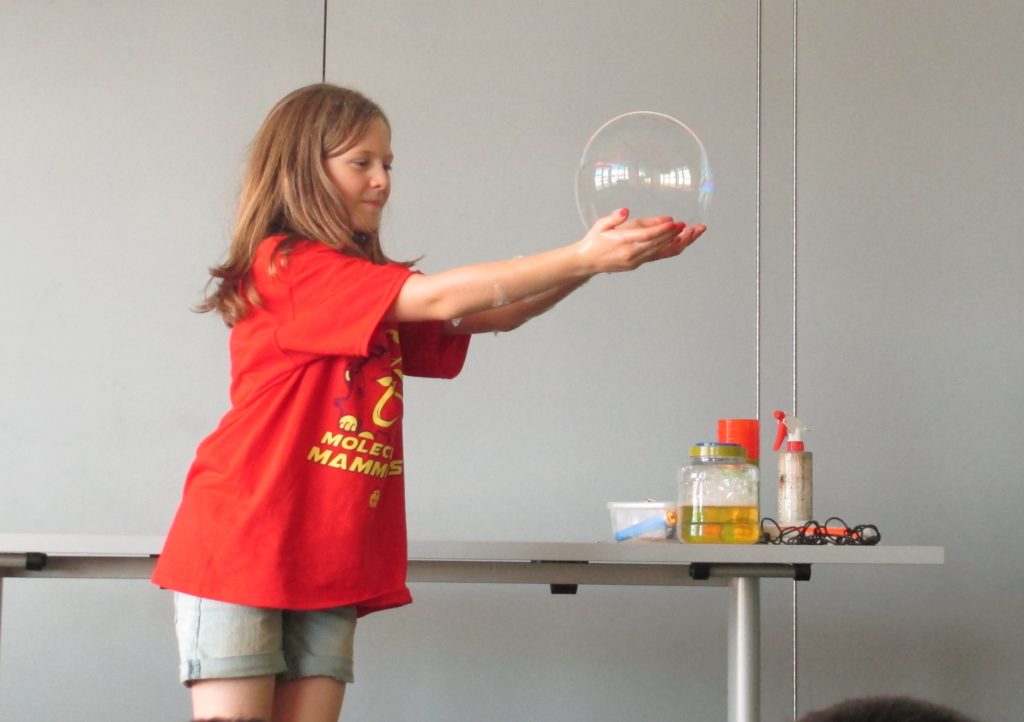Objectives
-
Make a bubble and understand its structure
-
Compare the elasticity of a bubble with the elasticity of other objects
-
Explore and demonstrate minimal surface structures using bubbles
-
Use knowledge of soap films and minimal surface structures to make bubbles of various sizes, shapes, and arrangements
Materials
Background
Bubble Structure
Bubbles are soap films wrapped around air. Soap films are made from soap and water. The soap film looks like a sandwich with soap as the bread on the outside and water as the filling on the inside.
Soap molecules have two ends, a hydrophobic end and a hydrophilic end. The hydrophobic end avoids water and attaches to oil. The hydrophilic end avoids oil and attaches to water. Soap thus helps attach oily dirt to water so the dirt can be washed away from clothes and dishes.

Surface Tension & Elasticity
Surface tension is the force between liquid molecules at the surface of the liquid (in this case water). The water molecules cling to each other, which causes the surface of the water to behave like an elastic sheet. Elastic substances tend to return to their original shape when they’re stretched.
Water doesn’t make stable, free-floating bubbles all by itself. If you blow a bubble in water, it pops quickly because the surface tension of the water is relatively high and the water is not very stretchy. Adding soap decreases the surface tension so that the water can stay stretched around the bubble.
Even as the bubble is blown up larger or is stretched in various ways, soap stabilizes bubbles by an action known as the Marangoni effect. In places where the bubble is stretched, the surface concentration of soap decreases, which causes the surface tension to increase. This area of increased surface tension springs back to its original form and prevents the bubbles from stretching to the point of popping. The result is spherical bubbles with a uniform surface tension.
Soap also reduces water evaporation so the bubbles last longer, although this effect is relatively small.
Minimal Surface Shapes
When you play with bubbles, you’ll notice that they come in predictable shapes. That’s because deforming a bubble takes energy. The bubble tends to spring back to the shape that is stretched as little as possible – the minimum surface. Floating around in the air, a bubble will become a sphere, because a sphere has the least surface area for a given volume of air. Another way to think about this is that the bubble is stretched most evenly as a sphere (as compared to an egg shape, or a cube). A shape with corners or edges means that the soap is stretched unevenly.
Tips for Producing Giant Bubbles!
Big bubbles are fun for all ages. Follow these tips for the best results:
- Make giant bubbles in an outdoor area to avoid slippery floors.
- Use gentle, smooth, strong, confident and fluid motions.
- Hold the wand fully open (strings tight) to make starting a bubble easier. Any breeze needs to be from behind you to help fill your bubble.
- Use shorter strings on large bubble wands, or raised platforms for smaller children as using large wands can tire their arms.
- Clear off the foam from the top of the bubble solution before using it as foam wrecks big bubbles.
- Make sure your hands are “wet” with bubble mix so they do not pop the bubbles as they are being made.
- Wet the inside of the whole container with bubble mix. If there is a dry spot it could pop your bubbles.
Vocabulary
elasticity: The tendency of materials to return to their original shape after being deformed.
hydrophilic: Attracted to water.
hydrophobic: Repelled from water.
Marangoni effect: When liquid flows away from regions of low surface tension to regions of high surface tension.
minimal surface shape: A shape that has the least surface area for a given volume of air.
surface tension: The force between water molecules at the surface of the water.
Other Resources
Science World | YouTube | Bubbles
Sciecne World| YouTube | How to Make an Awesome Bubble Wand at Home
Exploratorium | Soap bubbles
David A. Katz | The Chemistry (and a little bit of physics) of Soap Bubbles
Bubbles by Bernie Zubrowski, Little, Brown & Company, 1974. ISBN 0-316-98881-2-pbk.
Soap Bubbles and the Forces that Mould Them by Charles Vernon Boys, Cornell University Library, 1890.


